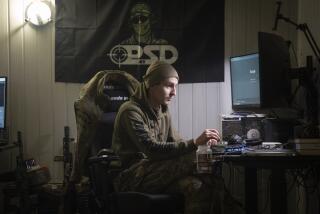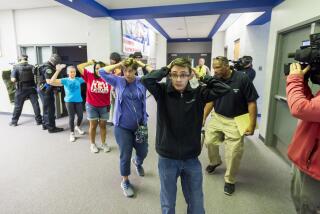Documentary : Sophisticated Software Takes the Place of Military Hardware in New War Games : NATO maneuvers on the German countryside were costly and destructive--until the Computer Age. Now military brass direct running battles on high-tech simulators, at a fraction of the expense.
- Share via
MITTERTEICH, Germany — This is the time of year when the rolling, rich fields and blacktopped roads of Bavaria have often been cluttered with grinding tanks, troop carriers and soldiers.
The post-harvest autumn season is military exercise time, when forces of the North Atlantic Treaty Organization would deploy across the German countryside, practicing to repulse a Soviet attack.
In the past, such maneuvers were costly, both in putting thousands of men and machines into action and in payments to local farmers for damage to fields and roadways.
But this year, to an unprecedented degree, senior commanders are conducting their major maneuvers not with hundreds of vehicles and thousands of troops, but with a master computer that simulates a running battle.
Besides being less disruptive to the German countryside, this training method is much cheaper than full-fledged maneuvers--a savings appropriate to the reduced threat from the Soviet Union and the collapsed Warsaw Pact.
A field maneuver involving a full division (17,000 troops) and 5,000 vehicles would cost about $9 million. A comparable computerized version run from a cavernous tent just north of this market town near the Czechoslovak border recently involved “800 people participating at a cost of about $350,000,” said the exercise director, Lt. Col. Bill Hatch.
“We call the increased use of battle simulators ‘training smart,’ ” added Maj. John Cooper, a staff officer with the 1st Armored Division.
Training with simulated war games is not new. But thanks to modern computer technology, the games are becoming increasingly realistic, forcing officers to respond to rapidly changing conditions closely matching those they would meet in the field.
One observer likened the contrast between old-fashioned war gaming and today’s computer simulations to that between slow-motion and fast-forward.
The exercises give commanders the feel of maneuvering large formations under battlefield conditions while lower-echelon officers and the troops, no longer needed as training props for the senior brass, get more experience in the field.
The five-day training exercise called Swift Lance III that Hatch was directing here was devised at corps headquarters in Stuttgart to simulate a numerically superior enemy attack moving south toward the city of Fulda, long a strategic site near the former East German border. The mission of the 1st Armored Division’s commander, Gen. Ronald Griffith, was to stop the advancing forces and then counterattack.
Griffith’s brigade commanders and other officers were scattered around Bavaria--none of them, ironically, within 100 miles of Fulda. An opposition forces commander determined attack tactics, with every move fed into the computer.
“I make sure things go smoothly here and nobody cheats,” Hatch said.
A sense of nervous tension pervaded the center as members of various units, in separate areas, bent over computer consoles, following the action and feeding detailed data to the battle computer.
Griffiths and his officers must take into consideration the actual conditions around Fulda, Hatch noted. “That means the terrain, the road network, the fact that refugees will be jamming them. Every bridge in Germany is marked on our maps with the weight it will bear. So the commander must maneuver his troops in a realistic manner--you can’t run heavy tanks over roads or bridges that won’t hold them.
“Further, units must be available and in condition to move,” Hatch added. “Sometimes units are depleted by casualties or out of position. You just can’t magically order them up. And almost all the maneuvers are done in real time, as they would be in field exercises.”
The software for the computerized maneuvers was developed by Pasadena’s Jet Propulsion Laboratory, which builds into the database all men, supplies and equipment involved in the exercise.
At command posts away from the simulation center, the mock battle seems all the more real. The division’s 1st Brigade and its staff of 150, for example, set up its command post in a sports yard at the edge of Mitterteich. Working in a blackout tent, Lt. Col. Dave Ozolek, the executive officer, bent over maps on a table and updated friendly and opposition troop positions.
Portable generators supplied dim lighting, and two-way radios crackled with messages, just as they would during an actual battle.
“First Battalion taking artillery fire,” reports the operations officer.
“Let’s get our own arty (artillery) on them,” replies Col. Ozolek. “Get the coordinates.”
The command staff plots the reported position of the enemy batteries and radios for artillery support. Sometimes it comes immediately, sometimes not--as would happen in war.
Pointing to the map table, Lt. Col. Ozolek tells a visitor: “The 3rd Brigade broke the first line yesterday but suffered casualties and is temporarily ineffective. Second Brigade is moving up. One of our battalions was cut up pretty bad. The division commander may ask us to move on a new axis of attack, so we have to spend tonight planing for that contingency.”
The division commander and the other brigade headquarters are going through the same process at their field locations scattered across a wide area.
“Within these canvas walls,” said the 41-year-old Ozolek, “it is very difficult for us to realize there are not 2,700 troops (the size of a brigade) maneuvering with their tanks and armored vehicles out there. That’s the idea: an exercise where you don’t know whether it is a maneuver or a simulation.”
“We have new staff officers and this is a really effective way to integrate them into our brigade battle team,” Ozolek added. “This week, we have been fighting the brigade--and training new staff officers. At the same time, the ordinary soldier is able to keep up his training at small-unit tactics--instead of moving endlessly around the countryside in a large-scale maneuver. At the lower level, there is no substitute for unit training in the field.”
While Swift Lance was under way, the soldiers of one of the 1st (Old Ironsides) Armored’s mechanized battalions were undergoing infantry training back at their garrison at Vilseck, the closest U.S. base to the Czechoslovak border.
Dozens of the 834-member 1/6 Battalion were supervised by Sgt. Maj. Bill Miller, who tramped through birches and pines with the chatter of machine guns and thump of artillery in the background. “During the huge, army-size Reforger exercises in Europe,” said the 42-year-old Vietnam combat veteran, “we were often moved 50 miles one way and 100 miles back--to give the generals practice. I prefer to spend that time training my men in the field.”
Equally enthusiastic about battle simulation was Mitterteich’s Mayor Karl Haberkorn, who dropped by the 1st Brigade’s command post to thank them and invite the Army back again.
The simulated maneuvers had avoided leaving the trash, the fuel spills and the emissions that hundreds of vehicles would have left.
“For years, we had problems with the damage caused during maneuvers,” said the mayor. “These new techniques are much better for the environment and our peaceful countryside. The Army is very welcome here.,”
More to Read
Sign up for Essential California
The most important California stories and recommendations in your inbox every morning.
You may occasionally receive promotional content from the Los Angeles Times.













